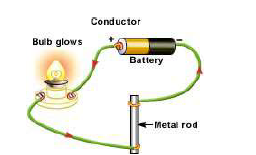The source of the DC supply can be dry cells in series giving 6 volts. The bulb, which should
be low power, indicates when the current is flowing. The electrodes may be carbon or steel,
perhaps mounted in a wooden support, cork or rubber stopper so as to keep the electrodes a
constant distance apart.

(i) Test the conductivity of solids by making a good contact between the surface of the
solid and the two electrodes. The surface of the solid must first be cleaned. All metals
conduct electricity. Carbon conducts electricity. Note whether non-metallic solids, e.g.
plastics, naphthalene, wax, sugar, sodium chloride and sulphur, conduct electricity.
(ii) Glass can be a conductor. Heat a glass rod until it becomes very hot and begins to
soften. Test the hot, soft part with the conductivity apparatus. When molten, glass is a
good conductor of electricity.
sharon kalunda answered the question on
April 12, 2019 at 08:16